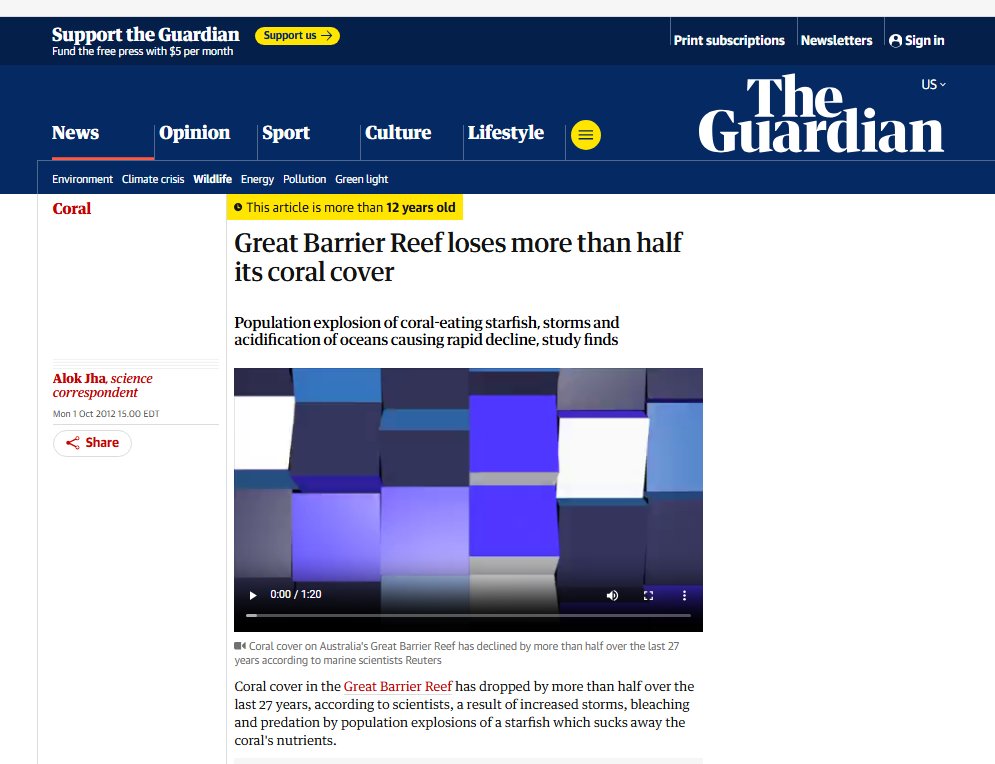Thread:
Scientific results are limited to the quality of data. When it comes to climate science, the data is shoddy - at best.
In 2012, scientists and news organizations trumpeted the demise of the Great Barrier Reef. What happened next shows the limitations of science.
Scientific results are limited to the quality of data. When it comes to climate science, the data is shoddy - at best.
In 2012, scientists and news organizations trumpeted the demise of the Great Barrier Reef. What happened next shows the limitations of science.

In 2012, a study published in the prestigious journal, PNAS, showed that the GBR had suffered a 50% decline in coral cover over a 27-year period. Climate scientists and the media ran with the horrors of acidifying seas and a warming climate.
But there was a problem.
But there was a problem.

The scientists could only go back to 1985 because, frankly, the data before 1985 was very limited and very suspect. As even the Coral Monitoring Network admits, coral cover had huge ranges of reliability even through the 90s. This was also true for the GBR. 

Still, the authors of the paper believed that they could take that 27-year snapshot and show that the GBR was in imminent collapse. As one scientist bloviated, "If the trend continued, coral cover could halve again by 2022."
And news organizations ran with this prediction.
And news organizations ran with this prediction.
The GBR was going to soon be a bleached boneyard!
Well, no. Science is only as good as the data. Unfortunately, making predictions about the future based on a less than three-decade snapshot where the first decade has such imprecision is fraught with problems.
Well, no. Science is only as good as the data. Unfortunately, making predictions about the future based on a less than three-decade snapshot where the first decade has such imprecision is fraught with problems.
What has happened since the 2012 paper? One can look to the Australian Institute of Marine Science. In the Northern GBR, cover actually appeared to go down until 2017 and has since recovered to its highest apparent levels in four decades. 

In the Central GBR, it hit its apparent low in 2012. But also bounced back to its highest apparent levels. 

In the Southern GBR, it has also bounced back to near apparent highs from 40 years ago.
Now, I say "apparent" levels because, again, the data during the early period is so variable as to make real determinations extremely difficult.
Now, I say "apparent" levels because, again, the data during the early period is so variable as to make real determinations extremely difficult.

One thing that we can see across all charts is that it isn't terribly clear that the GBR isn't going through natural oscillations or if it actually did have a dip and is more resilient than anyone understands or if this is just noise with no statistical differences.
Before anyone storms in and says, "denier," my point is that the data that we have on coral reefs is poor before the late 90s. Even now, there is significant imprecision.
Furthermore, no one can say that global coral levels in 2008 at 35% are "normal" or simply abnormally high.
Furthermore, no one can say that global coral levels in 2008 at 35% are "normal" or simply abnormally high.

That's the problem with taking data from small timeframes. Recency bias is a thing in science as well. Until we have a good understanding of what is "normal" for coral reefs, it is folly to make predictions about the future or to sound alarms.
Science is limited. Any scientist making pronouncements like, "the science is settled" and "this is going to happen by X year" isn't behaving like a scientist. I'm looking at you, @MichaelEMann.
Scientists are wrong a lot because science is a hard process. Remember that.
Scientists are wrong a lot because science is a hard process. Remember that.
• • •
Missing some Tweet in this thread? You can try to
force a refresh













